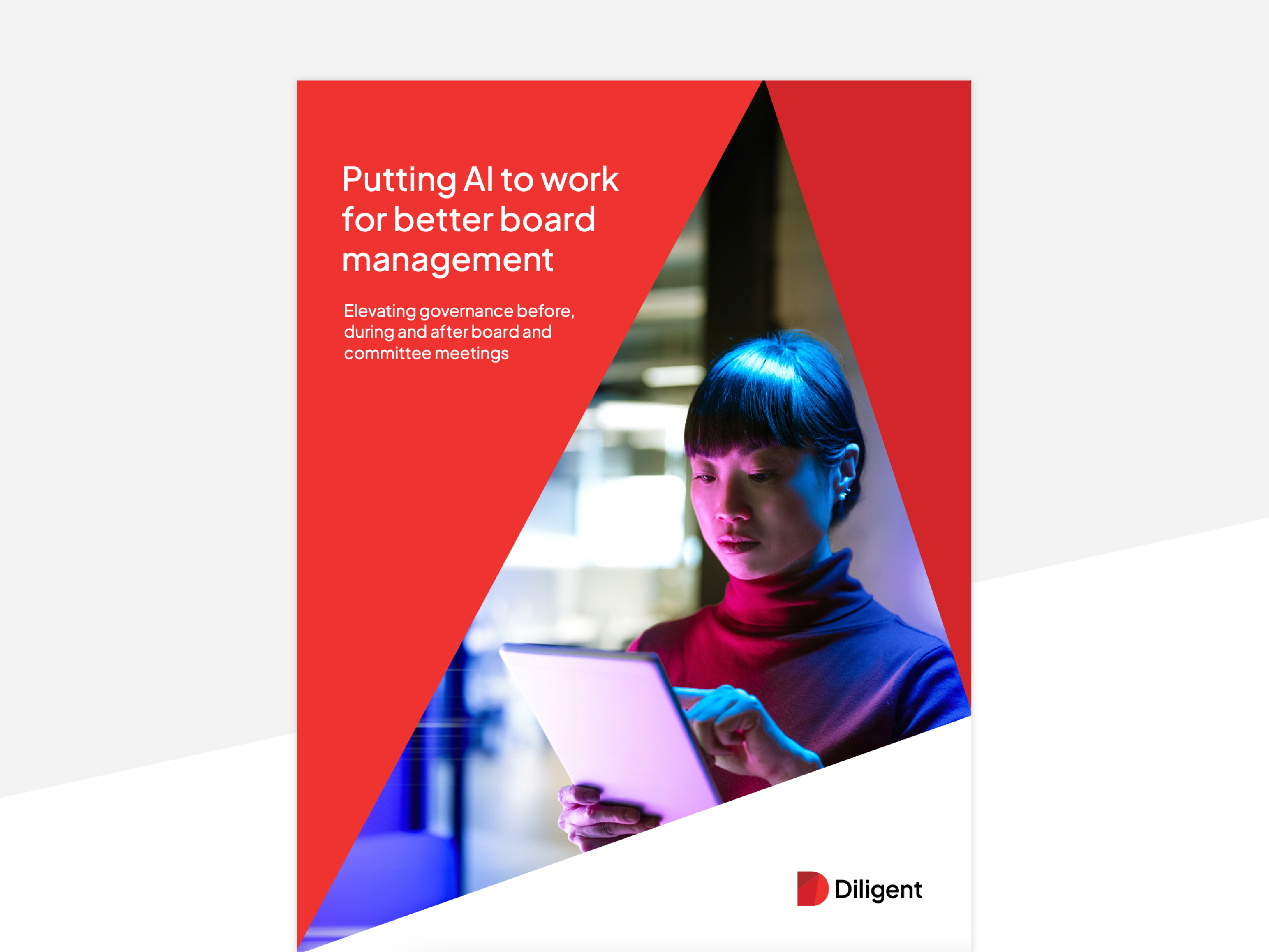How AI-powered tools transform board meeting management

Board meetings are where critical decisions take shape, risks are assessed, and long-term strategies are set. Yet, for the corporate secretaries, general counsels and board administrators charged with managing them, they are often logistical marathons — demanding hours of preparation, document distribution and coordination.
From agenda-building and board book compilation to securing approvals and capturing minutes, traditional board meeting workflows remain manual, fragmented and time-consuming. Today, such inefficiencies in governance ultimately slow down decision-making and expose organizations to compliance risks.
Purpose-built AI-powered tools are now changing how board meetings are run, freeing governance teams from administrative burdens and enabling directors to focus on informed decision-making, risk oversight and strategic governance.
If your organization is exploring AI for board meetings, this guide covers:
- Nine specific steps to transform meeting preparation, execution, and documentation
- The board's responsibility for ethical AI oversight
- AI board management software for tackling governance challenges across enterprise organizations
- Security and compliance considerations for selecting board management platforms
- Improvements organizations achieve through AI-powered governance automation
Step 1: Build an agenda that keeps meetings focused
A well-structured agenda is the backbone of a productive board meeting. But building one from scratch can be time-consuming — especially when manually pulling in agenda items, coordinating inputs, and making last-minute adjustments while ensuring strategic priorities receive appropriate attention. AI-powered board management technology helps by providing the following:
- Intuitive agenda-building tools allow contributors to securely access and edit documents in real time — ensuring that board members always have the latest updates.
- Drag-and-drop functionality makes it easy to customize agendas, copy previous meeting structures, and track discussion points.
- Smart prioritization capabilities help governance teams focus on the most critical strategic and risk management topics.
"Giving the information in advance helps board members better prepare. They can also go back to previous meetings, and if they have questions on what was discussed previously, they can review it easily. We also share the draft agenda before it's published to help show them what's going to be discussed at the meeting," says Catherine Hill, Executive Secretary at Vigo County School Corporation.
Overall, streamlined agenda creation enables a greater focus on strategic priorities that drive business outcomes.
AI Summit – Now on demand
Missed the AI Virtual Summit? Watch expert-led sessions on GRC, risk, audit & compliance — on your schedule.
Watch nowStep 2: Automate board book creation and eliminate manual preparation burdens
Before board documents can be reviewed, they need to be assembled — and for many governance teams, that's one of the most time-consuming and error-prone processes in board meeting preparation. Manually compiling board packs from Word documents, PDFs, spreadsheets, and presentations adds pressure to already tight timelines and increases the risk of version control errors.
The challenge intensifies for organizations managing committee structures, multi-jurisdictional operations, or frequent board meetings. Each additional layer of complexity multiplies the manual effort required while increasing the potential for documentation gaps that create compliance vulnerabilities.
To mitigate these vulnerabilities, board management technology offers the following capabilities:
- AI-powered document synthesis combines documents, spreadsheets, and presentations into structured, pre-formatted board books — generating accurate first drafts with minimal manual input.
- Dynamic content updates from the latest source files ensure that directors always receive consistent, up-to-date information.
- Built-in formatting and templating allow teams to create professional-quality materials aligned with board standards and corporate branding guidelines.
"Our [Diligent] platform has revolutionized how we access information, creating a seamless system of checks and balances across our committees. Before using this platform, we relied on disorganized systems, but now everything is streamlined on one platform, allowing us to manage our operations effortlessly. Features like real-time updates and easy document management have streamlined our operations, making our meetings more effective and efficient," says Bing Goldsworth, Executive Assistant at Organically Grown Company.
Ultimately, automating board book creation can significantly reduce manual work while improving accuracy and presentation quality — giving governance professionals more time to focus on strategic board support and risk analysis.
Step 3: Distribute and summarize board materials with intelligent efficiency
Once agendas are set and board books assembled, governance teams must securely distribute meeting materials. Without centralized systems, this process creates chaos — leading to version-control issues, last-minute scrambling, and directors receiving outdated or incomplete materials that undermine their ability to prepare effectively.
Even when materials are delivered on time, the result is often a dense, overwhelming board pack that makes it difficult for directors to identify the most important information before meetings. Directors managing multiple board commitments need efficient ways to prepare without sacrificing the depth of understanding required for informed decision-making.
Advanced platforms address these challenges through intelligent distribution and synthesis:
- AI-powered board book summarization condenses hundreds of pages of reports into key takeaways, ensuring directors can grasp essential insights. Built-in text-to-speech conversion also allows directors to prepare while commuting or traveling.
- Secure document sharing ensures all board members can access the latest, approved versions, eliminating confusion over updates.
- Automated distribution and notifications keep board members informed and remind them to review materials in advance.
With reliable document management and AI-driven summaries, directors are no longer buried in information — they arrive at meetings better prepared and ready to engage in meaningful strategic discussions.
Step 4: Keep communication secure with enterprise-grade collaboration
Board members often need to collaborate before meetings — yet email and unsecured messaging tools create governance risks that can expose organizations to regulatory scrutiny and confidentiality breaches. To handle these hurdles, board management technology provides:
- Secure messaging and virtual data rooms provide a confidential, encrypted space for board discussions and document sharing that meets enterprise security standards.
- AI-powered risk monitoring continuously analyzes peer company 10-K risk disclosures, internal risk data and third-party sources, surfacing relevant insights ahead of meetings.
- AI-powered board analytics bring real-time governance intelligence to the boardroom, surfacing key risk indicators, industry benchmarks, and compliance trends that support informed decision-making.
Directors need timely insights at their fingertips. Secure, intelligent communication platforms ensure both confidentiality and effectiveness.
Step 5: Optimize meeting discussions with AI-driven insights
A well-run board meeting focuses on strategic decisions, risk management and long-term planning. However, directors often struggle to extract key insights from dense materials, leading to discussions that lack focus or data-driven direction.
The challenge for governance professionals is ensuring this intelligence reaches directors in actionable formats that enhance rather than overwhelm meeting discussions. Leading platforms provide several capabilities to optimize board engagement:
- AI-powered meeting preparation tools can turn board book content into pointed questions categorized by subject and cited for easy reference to maximize important discussions and decisions.
- AI-assisted reporting dashboards provide the board with consolidated views of enterprise-wide risks and opportunities, integrating insights such as environmental, social, and governance (ESG) performance and cyber risk relative to competitors into comprehensive intelligence that supports strategic planning.
- Real-time market intelligence helps boards understand competitive positioning and industry trends that impact strategic decision-making, providing the external context that internal reports cannot capture.
- Intelligent benchmarking compares governance practices, risk exposures, and strategic initiatives against industry peers, helping boards identify both gaps requiring attention and areas where the organization leads its competitive set.
Step 6: Facilitate real-time meeting execution with intelligent tools
Once the meeting begins, governance teams need tools that support smooth execution without creating administrative distractions. Traditional meetings often struggle with managing live voting, capturing decisions, tracking attendance, and ensuring all participants can engage effectively regardless of location.
The challenge intensifies for organizations with virtual or hybrid board meetings, where technical difficulties can disrupt discussions, voting processes become cumbersome, and the lack of real-time documentation creates gaps that must be reconstructed later from memory or incomplete notes.
AI-enabled governance platforms provide comprehensive capabilities:
- Real-time voting and decision capture enable instant polling, formal resolutions, and recorded votes with complete audit trails.
- Live Q&A management allows directors to submit questions digitally during presentations, helping governance teams organize discussion flow and ensure all director concerns are addressed without disrupting meeting momentum.
- Collaborative annotation capabilities enable directors to highlight key points, add private notes, or flag items for follow-up discussion directly within board materials during meetings.
- Secure virtual meeting integration offers enterprise-grade video conferencing with board-specific security controls, ensuring remote directors can participate fully while maintaining the confidentiality required for board discussions.
Real-time tools eliminate the administrative friction that disrupts meeting flow, allowing boards to focus on strategic discussions rather than technical logistics. Proper execution also ensures that decisions, votes, and key discussion points are accurately captured as they occur. This reduces delays in post-meeting documentation.
Step 7: Capture meeting outcomes with AI-powered documentation
The work doesn't stop when the meeting ends — decisions, approvals, and follow-ups must be properly documented to meet regulatory requirements and maintain comprehensive audit trails. Traditional minute-taking is time-consuming, error-prone, and often requires multiple rounds of revisions. Intelligent platforms streamline the entire documentation process:
- AI-generated meeting minutes automatically capture key discussions, decisions, and action items — reducing the need for manual transcription while ensuring regulatory compliance.
- Risk scanning technology inspects board materials for risky language and potential compliance concerns, ensuring that legal and regulatory risks are flagged before they become part of the corporate record.
- Audit-ready documentation simplifies regulatory compliance with SEC, SOX, and corporate governance requirements while maintaining comprehensive records.
While AI accelerates minute creation and improves consistency, governance teams must maintain oversight throughout the process. AI-assisted drafting requires human review and approval to ensure accuracy, appropriate tone, and alignment with corporate policies.
The goal is not to eliminate human judgment but to free governance professionals from tedious transcription work so they can focus on ensuring minutes accurately reflect board discussions and decisions.
Step 8: Streamline minutes approval workflow and finalize the corporate record
Creating minutes is only half the challenge. The approval process often becomes a bottleneck that delays finalization of the corporate record. Traditional workflows involve multiple email exchanges, version control confusion, conflicting edits from different reviewers, and uncertainty about who has reviewed or approved what.
This approval friction creates real risks. Delayed minutes can create governance gaps during regulatory reviews or legal proceedings. Version control errors can result in different board members referencing different documents. And manual tracking of approval status forces governance teams to chase down busy directors and executives for sign-offs.
Advanced platforms eliminate these approval bottlenecks with the following features:
- Automated review routing sends draft minutes to designated reviewers in the proper sequence — board chair, legal counsel, committee chairs — with clear deadlines and automatic reminders that eliminate the need for manual follow-up.
- Intelligent version control tracks all changes, maintains a complete audit trail of edits, and prevents the confusion that occurs when multiple reviewers edit different versions simultaneously.
- Comment consolidation and resolution tracking aggregates feedback from multiple reviewers into a single view and helps governance teams address concerns systematically.
- Final record certification creates timestamped, immutable versions of approved minutes, complete with metadata that documents the entire approval chain — providing the audit trail that demonstrates proper governance processes.
Streamlined approval workflows transform what takes weeks of back-and-forth into processes that finalize minutes in days. This reduces governance gaps, improves compliance posture, and ensures the corporate record is complete when needed for regulatory reviews, audits, or legal proceedings.
Additionally, faster finalization means action items can be distributed sooner, accelerating execution on board decisions.
Step 9: Drive follow-ups and action items with intelligent accountability systems
Board meetings are only successful if decisions lead to action. Yet, too often, follow-ups fall through the cracks due to a lack of structure and tracking. This undermines board effectiveness and creates the perception that board guidance doesn't translate into operational results.
The challenge intensifies when action items span multiple business units, require coordination across global operations, or involve regulatory compliance deadlines where missed milestones create exposure.
Intelligent governance platforms ensure comprehensive follow-through:
- Action item tracking automatically assigns post-meeting tasks with clear deadlines and ownership, ensuring accountability.
- Smart reminders and progress updates keep key stakeholders informed, which is particularly important for regulatory compliance deadlines.
- Integrated compliance tracking links board actions to regulatory and governance obligations, helping organizations maintain comprehensive audit trails.
AI ensures board decisions are acted upon, reinforcing accountability while maintaining the documentation necessary for regulatory compliance and demonstrating to stakeholders that board oversight translates into operational execution.
Transform your board operations
See how AI-powered governance tools streamline meeting preparation and enhance board effectiveness for enterprise organizations.
Request a demoThe board's responsibility for ethical AI oversight
As AI becomes infrastructure rather than innovation, boards face a critical fiduciary responsibility: ensuring that AI tools used in governance uphold the highest standards of ethics, transparency, and accountability.
Not all AI solutions are created equal for governance applications. Organizations must prioritize platforms designed for board-level security, compliance, and governance requirements.
The most effective AI-driven board management platforms maintain rigorous data security standards, provide complete transparency into how AI processes information, and ensure governance professionals and boards retain full control over all AI-assisted decisions.
Key considerations for responsible AI adoption in board operations include:
- Data security and confidentiality: Enterprise-grade encryption, secure data storage, and comprehensive access controls that protect sensitive board materials and privileged communications.
- Transparency and explainability: Clear visibility into how AI generates recommendations, identifies risks, and processes board materials — avoiding "black box" systems that obscure decision-making logic.
- Human oversight and final authority: AI should enhance human judgment, not replace it. Governance professionals must review and approve all AI-generated content before publication, and boards must maintain ultimate authority over strategic decisions.
- Bias detection and mitigation: Regular audits of AI outputs to identify and address potential biases in recommendations, risk assessments, or analytical insights.
- Regulatory compliance alignment: AI systems must support — not complicate — compliance with SEC requirements, Sarbanes-Oxley documentation standards, and corporate governance regulations across all jurisdictions.
Organizations that prioritize these principles mitigate AI-related risks and establish governance infrastructure that enhances stakeholder confidence, improves board effectiveness, and demonstrates effective oversight.
How AI technology transforms board meeting management
The right technology infrastructure builds foundations for solid governance quality. Organizations should evaluate board management platforms based on capabilities that address governance challenges — from initial planning through meeting execution, to final documentation and follow-through.
With this in mind, Diligent offers a comprehensive suite of AI-driven board management tools. This includes the following:
- Diligent Boards provides the foundation for AI-enhanced board operations, offering enterprise-grade security, intuitive collaboration tools, and intelligent automation throughout the meeting lifecycle.

- Smart Builder synthesizes raw documents, financial reports, and presentations into board books with minimal manual effort. This transforms what traditionally required days or weeks of preparation into streamlined workflows that maintain institutional quality standards while dramatically reducing administrative burden.
- SmartPrep turns board materials into intelligent preparation tools, generating discussion questions categorized by strategic priority and cited to specific board book sections. This ensures directors arrive at meetings prepared to engage on the most important topics.
- Smart Risk Scanner provides automated compliance oversight by analyzing board materials for risky language, regulatory issues, and potential legal exposure before documents become part of the corporate record. This proactive risk identification helps governance teams address concerns early rather than discovering problems during regulatory audits or legal disputes.
Ready to see how Diligent’s board management solutions can transform your board meeting management? Request a demo.
FAQs about AI-assisted board meeting management
What security considerations are most important for AI-powered board management tools?
Enterprise AI governance tools must meet federal cybersecurity standards, including dataset verification protocols, secure data storage requirements, and comprehensive audit trails.
How does AI board management software help with regulatory compliance?
AI governance platforms automate compliance with SEC requirements, including cybersecurity incident disclosure, insider trading policy reporting in Form 10-K filings, and comprehensive audit trail maintenance for Sarbanes-Oxley compliance.
How do AI governance tools handle privileged attorney-client communications?
Enterprise-grade AI board management platforms feature secure, encrypted environments specifically designed for privileged communications between boards, management, and legal counsel. These systems maintain the segregation of privileged information, provide comprehensive access logs for legal review, and ensure compliance with attorney-client privilege requirements, while enabling efficient governance and collaboration.
What measurable improvements can organizations expect from AI board management implementation?
Organizations typically report substantial improvements in board meeting preparation workflows and document management efficiency. AI-powered summarization tools help directors better understand complex materials, leading to more focused strategic discussions. Additionally, automated compliance tracking can reduce regulatory risk exposure and provide comprehensive audit trail capabilities.
Transform your board operations with Diligent’s governance tools designed for enterprise security and compliance requirements.
Get the full guide to boardroom AI
Read our comprehensive guide to using AI tools before, during and after your board meetings.
Download todayMore to explore

Can AI be trusted to influence governance and board-level decision-making?
Learn how AI shapes boardroom decisions while balancing security and trust issues.

Harnessing AI for more efficient and effective board pack preparation
Discover how AI transforms board pack preparation, enhancing efficiency and accuracy while empowering board directors to make better decisions, faster.

AI for smarter board management
See how AI is transforming corporate governance. Learn how to automate tasks, enhance compliance and make data-driven board decisions. Download now.

